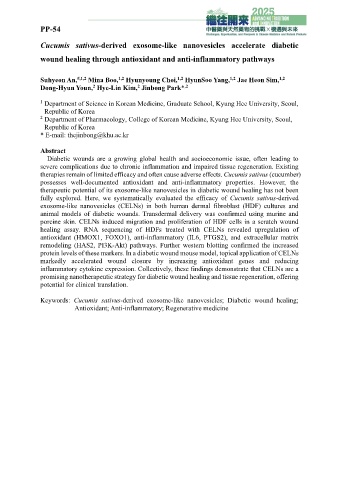Page 237 - 2025中醫藥與天然藥物聯合學術研討會-中醫藥與天然藥物的挑戰X機遇與未來大會手冊
P. 237
PP-54
Cucumis sativus-derived exosome-like nanovesicles accelerate diabetic
wound healing through antioxidant and anti-inflammatory pathways
1,2
1,2
1,2
Suhyeon An, #,1,2 Mina Boo, Hyunyoung Choi, HyunSoo Yang, Jae Heon Sim,
1,2
2
Dong-Hyun Youn, Hye-Lin Kim, Jinbong Park*
,2
2
1 Department of Science in Korean Medicine, Graduate School, Kyung Hee University, Seoul,
Republic of Korea
2 Department of Pharmacology, College of Korean Medicine, Kyung Hee University, Seoul,
Republic of Korea
* E-mail: thejinbong@khu.ac.kr
Abstract
Diabetic wounds are a growing global health and socioeconomic issue, often leading to
severe complications due to chronic inflammation and impaired tissue regeneration. Existing
therapies remain of limited efficacy and often cause adverse effects. Cucumis sativus (cucumber)
possesses well-documented antioxidant and anti-inflammatory properties. However, the
therapeutic potential of its exosome-like nanovesicles in diabetic wound healing has not been
fully explored. Here, we systematically evaluated the efficacy of Cucumis sativus-derived
exosome-like nanovesicles (CELNs) in both human dermal fibroblast (HDF) cultures and
animal models of diabetic wounds. Transdermal delivery was confirmed using murine and
porcine skin. CELNs induced migration and proliferation of HDF cells in a scratch wound
healing assay. RNA sequencing of HDFs treated with CELNs revealed upregulation of
antioxidant (HMOX1, FOXO1), anti-inflammatory (IL6, PTGS2), and extracellular matrix
remodeling (HAS2, PI3K-Akt) pathways. Further western blotting confirmed the increased
protein levels of these markers. In a diabetic wound mouse model, topical application of CELNs
markedly accelerated wound closure by increasing antioxidant genes and reducing
inflammatory cytokine expression. Collectively, these findings demonstrate that CELNs are a
promising nanotherapeutic strategy for diabetic wound healing and tissue regeneration, offering
potential for clinical translation.
Keywords: Cucumis sativus-derived exosome-like nanovesicles; Diabetic wound healing;
Antioxidant; Anti-inflammatory; Regenerative medicine

